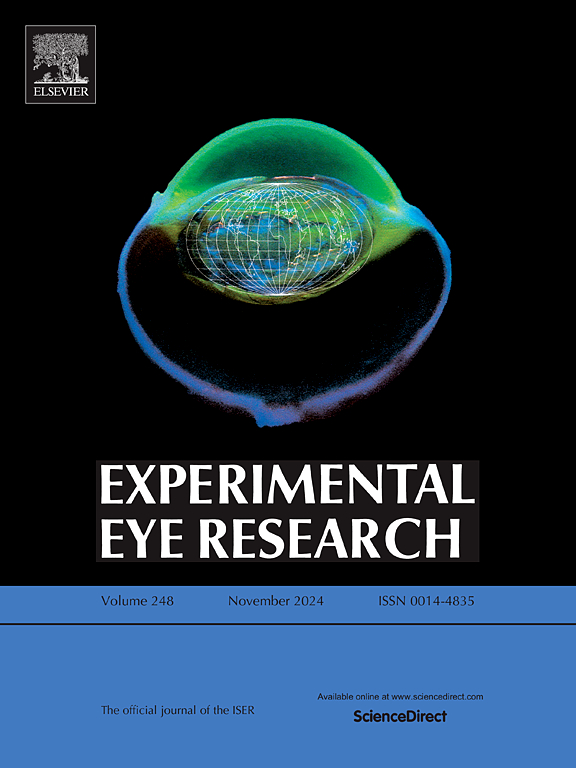Metabolic responses of rabbit corneas to normoxic and hypoxic conditions in the Ex Vivo Eye Irritation Test: An alternative to animal experimentation
IF 3
2区 医学
Q1 OPHTHALMOLOGY
引用次数: 0
Abstract
The cornea relies on oxygen for its physiological function and therefore for proper vision. Hypoxia induces significant metabolic and structural changes in in vivo corneal models, which underscore the importance of oxygenation in maintaining corneal function and transparency. This study investigates the impact of hypoxia on corneal metabolism using the live-animal-free Ex Vivo Eye Irritation Test (EVEIT) system. New Zealand white rabbit corneas, sourced from the slaughter industry, were incubated in an EVEIT bioreactor for 5 h under normoxic (20–21% oxygen) or hypoxic conditions (5–7% oxygen induced by argon). Macroscopic assessment and Optical Coherence Tomography (OCT) analyzed corneal transparency and central thickness respectively. The metabolic activity was assessed by quantifying lactate concentrations in both the culture medium within the bioreactor and the corneal tissue, employing photometric techniques for measurement. Significant lactate accumulation was observed in corneas under hypoxic conditions, accompanied by increased corneal thickness compared to normoxic conditions. These corneal metabolic changes observed under short-term hypoxic conditions in our ex vivo live-animal-free EVEIT system align closely with those previously recorded in vivo. Considering that the EVEIT system is consistent with in vivo models and that corneal metabolic changes may contribute to various corneal pathologies and dystrophies, EVEIT presents a promising tool and a viable alternative to animal experimentation in corneal ophthalmologic research.
在离体眼睛刺激试验中,兔角膜对常氧和缺氧条件的代谢反应:一种替代动物实验的方法。
角膜依靠氧气来维持其生理功能,从而维持正常的视力。缺氧在体内角膜模型中引起了显著的代谢和结构变化,这强调了氧合在维持角膜功能和透明度方面的重要性。本研究采用无活体动物离体眼刺激试验(EVEIT)1系统研究缺氧对角膜代谢的影响。将来自屠宰行业的新西兰白兔角膜在EVEIT生物反应器中,在常氧(20-21%氧气)或缺氧(5-7%氧气)条件下孵育5小时。宏观评价和光学相干断层扫描(OCT)2分别分析角膜透明度和中心厚度。代谢活性通过量化生物反应器内培养基和角膜组织中的乳酸浓度来评估,采用光度法进行测量。与正常缺氧条件相比,在缺氧条件下角膜中观察到明显的乳酸积累,并伴有角膜厚度的增加。在我们的离体无活体EVEIT系统中,在短期缺氧条件下观察到的这些角膜代谢变化与先前在体内记录的变化密切相关。考虑到EVEIT系统与体内模型一致,并且角膜代谢变化可能导致各种角膜病理和营养不良,EVEIT是角膜眼科研究中一个有前途的工具和可行的替代动物实验。
本文章由计算机程序翻译,如有差异,请以英文原文为准。
求助全文
约1分钟内获得全文
求助全文
来源期刊

Experimental eye research
医学-眼科学
CiteScore
6.80
自引率
5.90%
发文量
323
审稿时长
66 days
期刊介绍:
The primary goal of Experimental Eye Research is to publish original research papers on all aspects of experimental biology of the eye and ocular tissues that seek to define the mechanisms of normal function and/or disease. Studies of ocular tissues that encompass the disciplines of cell biology, developmental biology, genetics, molecular biology, physiology, biochemistry, biophysics, immunology or microbiology are most welcomed. Manuscripts that are purely clinical or in a surgical area of ophthalmology are not appropriate for submission to Experimental Eye Research and if received will be returned without review.
 求助内容:
求助内容: 应助结果提醒方式:
应助结果提醒方式:


